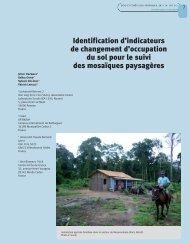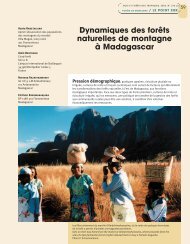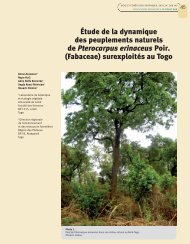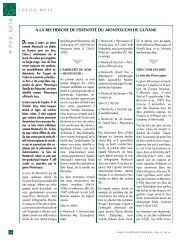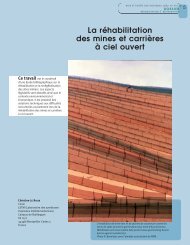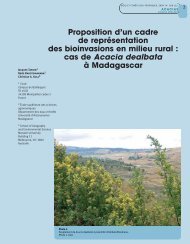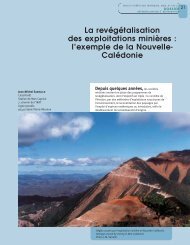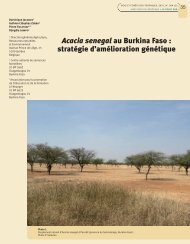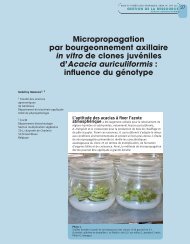Multiplication par drageonnage d'Isoberlinia doka et I. tomentosa au ...
Multiplication par drageonnage d'Isoberlinia doka et I. tomentosa au ...
Multiplication par drageonnage d'Isoberlinia doka et I. tomentosa au ...
- No tags were found...
Create successful ePaper yourself
Turn your PDF publications into a flip-book with our unique Google optimized e-Paper software.
50BOIS ET FORÊTS DES TROPIQUES, 2006, N° 289 (3)FOCUS / SUCKERINGMarra Dourma, Kudzo Atsu Guelly,Kouami Kokou, Komlan Batawila,Kperkouma Wala,Ronald Bellefontaine,Koffi AkpaganaRÉSUMÉMULTIPLICATION PARDRAGEONNAGE D’ISOBERLINIADOKA ET I. TOMENTOSA AU SEINDES FORMATIONS ARBORÉESDU NORD-TOGOL’étude cherche à montrer l’importanceque revêt la propagation végétative<strong>par</strong> <strong>drageonnage</strong> d’Isoberlinia<strong>doka</strong> Craib. & Stapf. <strong>et</strong> d’I. <strong>tomentosa</strong>(Harms) Craib. & Stapf. Les trav<strong>au</strong>xde recherche se sont appuyés sur 74relevés installés sur cinq sites richesen Isoberlinia sp. pl. ayant subi différentesintensités d’anthropisation.Une analyse statistique des descripteursdu milieu <strong>et</strong> des <strong>par</strong>amètresliés à la régénération a été réalisée.Le t<strong>au</strong>x d’arbres issus du <strong>drageonnage</strong>est plus élevé chez I. <strong>tomentosa</strong>que chez I. <strong>doka</strong>. respectivement 83<strong>et</strong> 56 % dans les champs <strong>et</strong> lesjachères, 39 <strong>et</strong> 35 % en forêt, où l’impactde l’homme est plus faible. Leurrése<strong>au</strong> radiculaire, qui comporte de 8à 40 drageons (en moyenne 12 chezI. <strong>doka</strong> contre 16 chez I. <strong>tomentosa</strong>),est plus concentré sous les houppiersdes arbres. Cela contribue àexpliquer la quasi-monospécificitédes peuplements fermés. Parfois,des drageons surgissent à plus de10 mètres de l’arbre mère. C<strong>et</strong>te aptitude<strong>au</strong> <strong>drageonnage</strong> peut êtreexploitée pour la régénération <strong>et</strong>l’aménagement à faible coût de cesforêts, notamment dans les zones àfort stress hydrique.Mots-clés : Isoberlinia, <strong>drageonnage</strong>,sylviculture, anthropisation, Togo.ABSTRACTPROPAGATION OF ISOBERLINIADOKA AND I. TOMENTOSA BYSUCKERING IN TREE FORMATIONSIN NORTHERN TOGOThis study highlights the role of veg<strong>et</strong>ativepropagation by suckering ofIsoberlinia <strong>doka</strong> Craib. & Stapf. andI. <strong>tomentosa</strong> (Harms) Craib. & Stapf.Data were collected from 74 plotschosen in five sites in which humanactivities are gradually encroaching.Community Analysis Package (CAP)software was used for statisticalanalyses of environmental characteristicsand to d<strong>et</strong>ermine regenerationrates. The rate for trees grown fromsuckers varied from 56 to 83% infields and fallows. For I. <strong>doka</strong> andI. <strong>tomentosa</strong> respectively; the rate fellto 35 and 39 % in forests wherehuman impact is low. The rate forI. <strong>tomentosa</strong> was always higher thanfor I. <strong>doka</strong>. The rooting systems of th<strong>et</strong>rees excavated had 8 to 40 suckers(12 for I. <strong>doka</strong> and 16 for I. <strong>tomentosa</strong>).These were more concentratedunder the tree crowns, whichaccounts for the fact that somes<strong>par</strong>sely stocked areas were almostmono-specific. In some cases, a fewroot suckers appeared at most10 m<strong>et</strong>res away from the main tree.Root suckering ability could be usedin tree formations for low-cost regenerationand management, <strong>par</strong>ticularlyin areas with high water stress.Keywords: Isoberlinia, suckering, silviculture,human alteration, Togo.RESUMENPROPAGACIÓN POR RETOÑADO DEISOBERLINIA DOKA E I. TOMENTOSAEN FORMACIONES ARBÓREASDEL NORTE DE TOGOEste estudio pr<strong>et</strong>ende mostrar laimportancia que tiene la propagaciónveg<strong>et</strong>ativa por r<strong>et</strong>oñado de Isoberlinia<strong>doka</strong> Craib. & Stapf. y deI. <strong>tomentosa</strong> (Harms) Craib. & Stapf.Los trabajos de investigación sebasaron en 74 registros instaladosen cinco lugares abundantes enIsoberlinia sp.pl. que habían soportadodistintas intensidades de antropización.Se realizó un análisis estadísticode los descriptores del medioy de los <strong>par</strong>ám<strong>et</strong>ros vinculados a laregeneración. La tasa de árboles provenientesdel r<strong>et</strong>oñado es más altaen I. <strong>tomentosa</strong> que en I. <strong>doka</strong>.Siendo, respectivamente, del 83 ydel 56% en campos y barbechos, ydel 39 y el 35% en el bosque, dondeel impacto del hombre es menor. Susistema radicular, que comprende de8 a 40 vástagos (promedio de 12 enI. <strong>doka</strong> frente a 16 en I. <strong>tomentosa</strong>),presenta una mayor concentraciónbajo las copas de los árboles. Estocontribuye a explicar la casi monoespecificidadde las masas cerradas.Algunas veces, surgen vástagos amás de 10 m<strong>et</strong>ros del árbol madre.Esta aptitud <strong>par</strong>a el r<strong>et</strong>oñado puedeexplotarse <strong>par</strong>a la regeneración y laordenación a bajo costo de estosbosques, especialmente en las zonasde alto estrés hídrico.Palabras clave: Isoberlinia, r<strong>et</strong>oñado,silvicultura, antropización, Togo.




